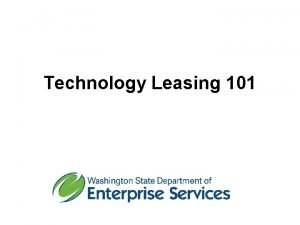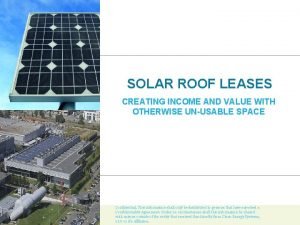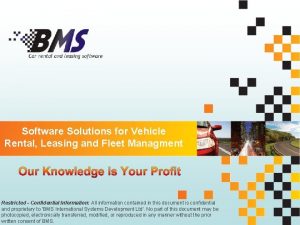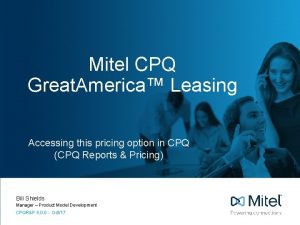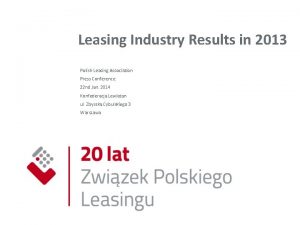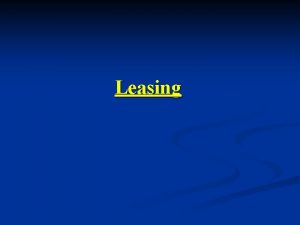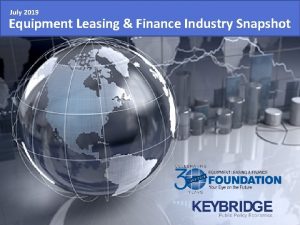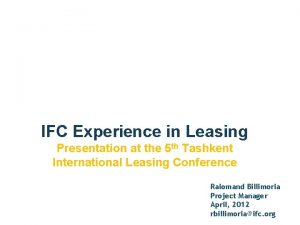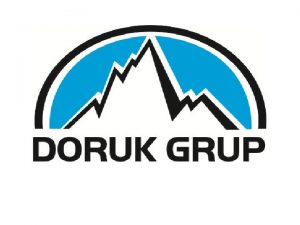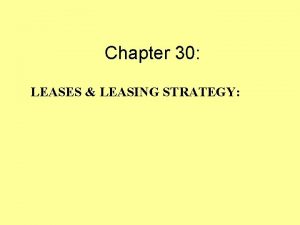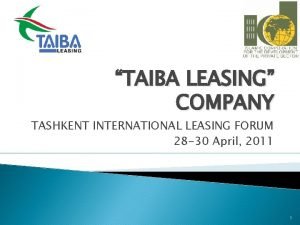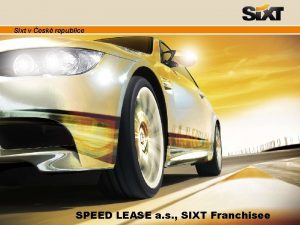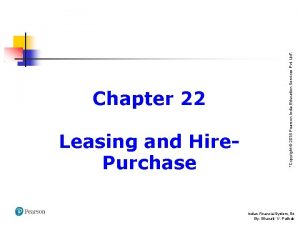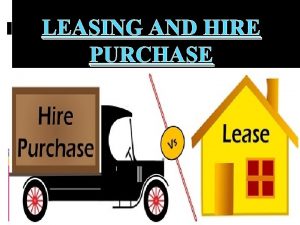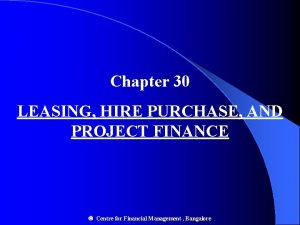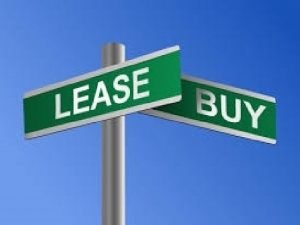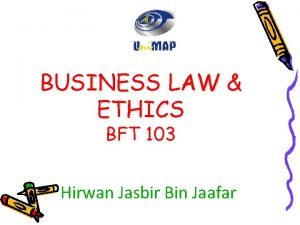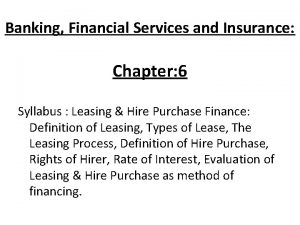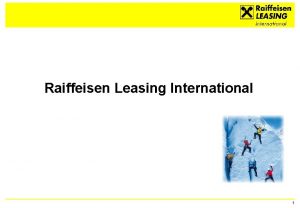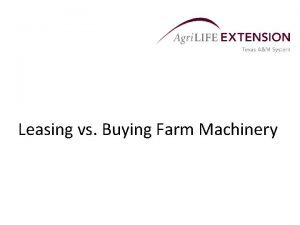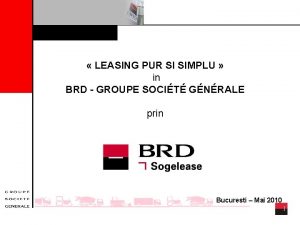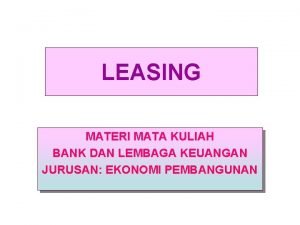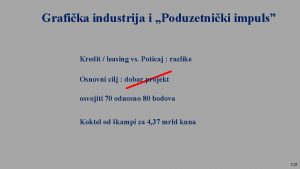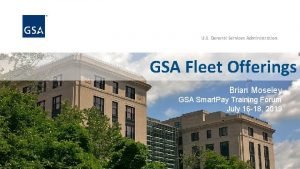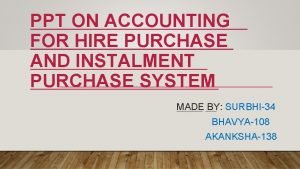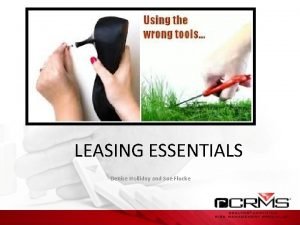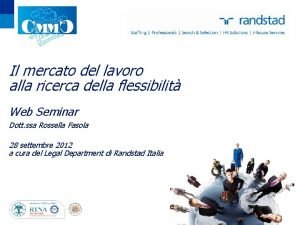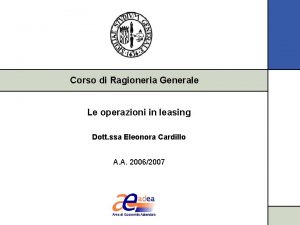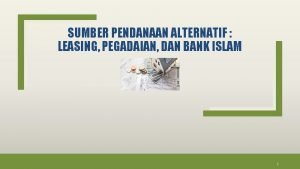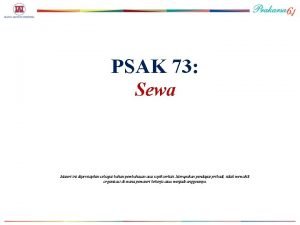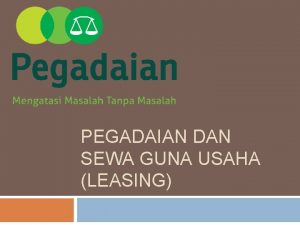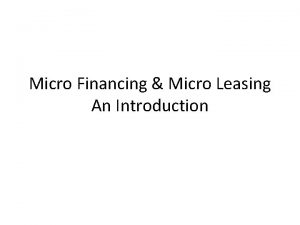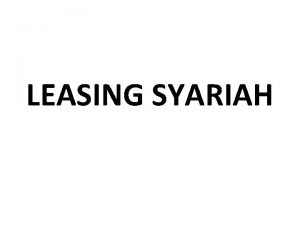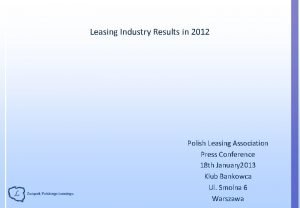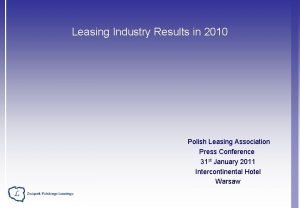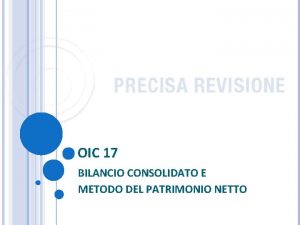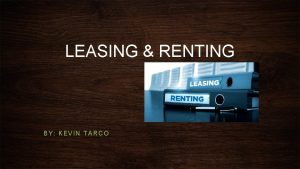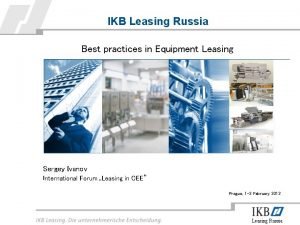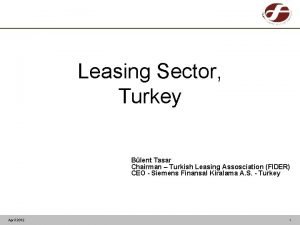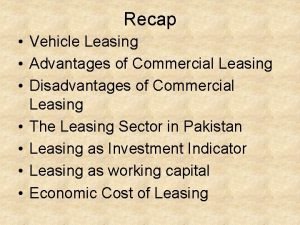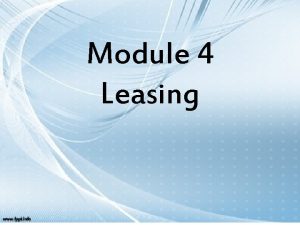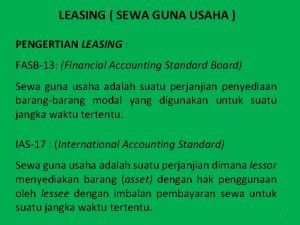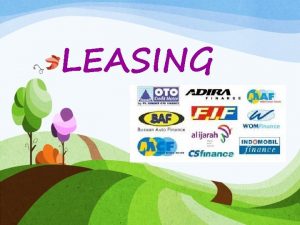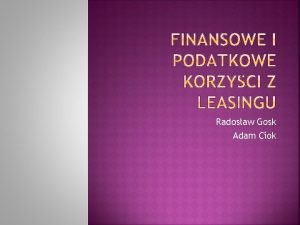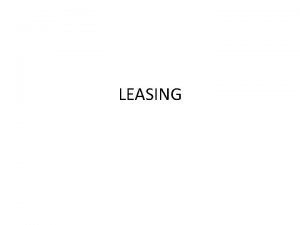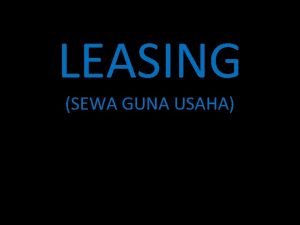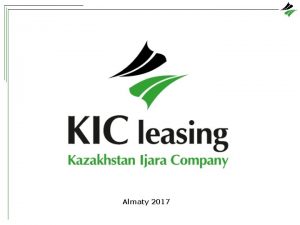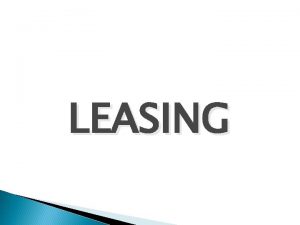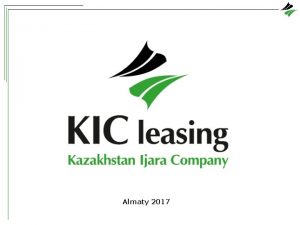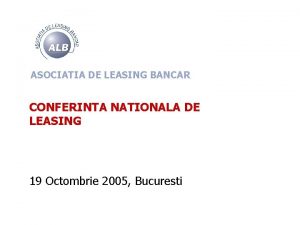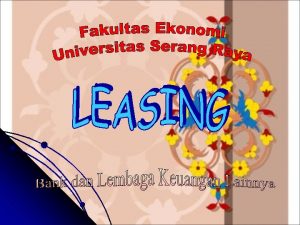Slide 18 1 Chapter 18 LEASING 1 Slide


















































- Slides: 50

Slide 18. 1 Chapter 18 LEASING 1

Slide 18. 2 By the end of this chapter, you should be able to: critically discuss the reasons for IAS 17; account for leases by the lessee; critically discuss the reasons for the proposed revision of IAS 17. 2

Slide 18. 3 WHAT IS A LEASE? Leases are defined in IAS 17 . . . an agreement whereby the lessor conveys to the lessee in return for a payment or a series of payments the right to use an asset for an agreed period of time. This includes contracts for the hire of an asset that contain a provision giving the hirer an option to acquire title to the asset upon the fulfilment of agreed conditions. It is a legal agreement whereby the lessee (the user) obtains the right to use an asset for an agreed period. 3

Slide 18. 4 What is a lease? The right to use the asset is passed from In return for the right to the lessor (the legal use the asset, the owner) of the asset to lessee pays a rental to another party (the lessor. Legal ownership is lessee). retained by the lessor – the person granting the lease. 4

Slide 18. 5 Types of leases Finance lease transfers substantially all the risks and rewards incidental to ownership of an asset to the lessee. Operating lease A lease other than a finance lease. An operating lease is a rental agreement. Title may or may not eventually be transferred. The lessee obtains practical ownership. 5

Slide 18. 6 Figure 18. 1 IAS 17 aid to categorising operating and finance leases 6

Slide 18. 7 Lease cancellation Finance lease only possible: (a) upon the occurrence of some remote contingency; (b) with the permission of the lessor; (c) if the lessee enters into a new lease for the same or an equivalent asset with the same lessor; or (d) upon payment by the lessee of such an additional amount that, at inception of the lease, continuation of the lease is reasonably certain. Operating lease can be cancelled at any time by either party – usually with one month’s notice. 7

Slide 18. 8 Situations and Indicators of Finance Lease IAS 17 outlines examples of situations that would normally lead to a lease being classified as a finance lease: The lease transfers ownership of the asset to the lessee by the end of the lease term. The lessee has the option to purchase the asset at a price that is expected to be sufficiently lower than the fair value at the date of the option exercisability. It is reasonably certain, at the inception of the lease, that the option will be exercised. The lease term is for the major part of the economic life of the asset even if the title is not transferred. At the inception of the lease the present value of the minimum lease payments amounts to at least substantially all of the fair value of the leased asset. The leased assets are of such a specialized nature that only the lessee can use them without major modifications. 8 http: //www. ifrsbox. com/summary-of-ias-17 -leases/

Slide 18. 9 Situations and Indicators of Finance Lease IAS 17 also lists 3 indicators that could also lead to lease being classified as a finance, but those are not always conclusive: If the lessee is entitled to cancel the lease, the lessor’s losses associated with the cancellation are borne by the lessee. Gains or losses from fluctuations in the fair value of the residual fall to the lessee (for example, by means of a rebate of lease payments). The lessee has the ability to continue to lease for a secondary period at a rent that is substantially lower than market rent. 9 http: //www. ifrsbox. com/summary-of-ias-17 -leases/

Slide 18. 10 Finance lease Capitalised in the lessee’s accounts: the leased item is recorded as an asset and the obligation for future payments should be recorded as a liability in the statement of financial position. Operating lease Lessee is required to expense the annual payments as a rental through the income statement. 10

Slide 18. 11 Operating leases Treatment conforms to the legal interpretation and corresponds to the lease accounting practice that existed before IAS 17 No asset or obligation is shown on the statement of financial position The operating lease rentals payable are charged as expenses to the income statement on a straight-line basis. 11

Slide 18. 12 Operating leases disclosure Total of rentals charged as an expense in the income statement Payments committed to make during the next year, in the second to fifth years inclusive, and over 5 years. 12

Slide 18. 13 OPERATING LEASE ILLUSTRATION Clifford plc negotiates a lease to begin on 1 January 20 X 1 with the following terms: Terms of lease – 4 years Estimated useful life of machine – 9 years Age of machine at inception of lease – 4 years Purchase price of new machine – £ 75, 000 Annual payments – £ 8, 000. 13

Slide 18. 14 OPERATING LEASE ILLUSTRATION (CONTINUED) Classify as an operating lease because: It applies only to a part of the asset’s useful life and The present value of the lease payments does not constitute substantially all of the fair value The amount of the annual rental paid – £ 8, 000 – will be charged to the income statement and disclosed There will also be a disclosure of the ongoing commitment with a note that £ 8, 000 is payable within 1 year and £ 24, 000 within 2 to 5 years. 14

Slide 18. 15 Finance lease 15

Slide 18. 16 Finance lease At the commencement of the lease term, lessee should recognize an asset and a lease liability at the lower of the fair value of the asset and the present value of the minimum lease payments. The discount rate for calculating the present value of the minimum payments is the interest rate implicit in the lease. The accounting entry is as follows: 16 http: //www. ifrsbox. com/summary-of-ias-17 -leases/

Slide 18. 17 Finance lease Subsequent Measurement There are 2 things to take care about after initial recognition: 1. Minimum lease payments should be apportioned between the finance charge (interest) and the reduction of the outstanding lease liability. The finance charge should be allocated so as to produce a constant periodic rate of interest (interest rate implicit in the lease) on the remaining balance sheet liability. In practice, actuarial method is used a lot to work out the allocation. The basic accounting entry of minimum lease payment paid to the lessor is as follows: 2. Lessee should charge the depreciation expense related to the assets held under finance leases. http: //www. ifrsbox. com/summary-of-ias-17 -leases/ 17

Slide 18. 18 Finance lease Asset cost lowest of Present value (PV) lease payments or Fair value Depreciation Estimated useful life period Or shortest of Lease period Net book value = Asset cost - Depreciation Liability at a lease date = Asset cost 18

Slide 18. 19 Finance lease Finance charge = Total minimun lease payments Less Asset cost Finance charge allocated over the term of the lease Acturial Sum of digits Straight line Liability reduced by (Finance lease – Lease payment) 19

Slide 18. 20 Finance lease Sum of the digits Acturial This method (‘Rule of This applies a constant periodic 78’) is much easier to apply than the actuarial charge to the method. The finance balance of the charge is apportioned to leasing obligation accounting periods on a and is calculated reducing scale – method by applying present used by Elliott & Elliott value factors to the annual lease payments Straight line This spreads the finance charge equally over the period of the lease. 20

Slide 18. 21 21

Slide 18. 22 FINANCE CHARGE ALLOCATION USING ACTUARIAL METHOD PP 480 -481(PP 335 -336) Figure 18. 2 Finance charge allocation using actuarial method, Interest amount is finance charge for each year. 22

Slide 18. 23 FINANCE LEASE ILLUSTRATED – SIMILAR TO CLIFFORD EXAMPLE PP. 478 -480 (PP. 333336) Boonaloo Ltd entered into a lease on following terms: Fair value of the leased asset 20, 000 Term of the lease 5 years Annual lease payments in arrears £ 4, 500 Expected value of asset at lease end nil Implicit rate of interest 4% 23

BOONALOO LTD - COMPARE FV WITH PV OF MINIMUM LEASE PAYMENT Slide 18. 24 FV of lease £ 20, 000 PV of instalments: 4500/(1. 04) + 4500/(1. 04)2 + 4500/(1. 04)3 + 4500/(1. 04)4 + 4500/(1. 04)5 = 20, 003, or 4500(PVIFA 4%, 5) = 4500 x 4. 452 = 20, 034 PV is very close to fair value, therefore capitalise at fair value. 24

Slide 18. 25 BOONALOO LTD – STEP APPROACH Step 1 Capitalise lease at FV = £ 20, 000 Step 2 Straight-line depreciation = £ 4, 000 Step 3 Asset in statement of financial position Year 1 20, 000 – 4, 000 = £ 16, 000 Year 2 16, 000 – 4, 000 = £ 12, 000 Year 3 12, 000 – 4, 000 = £ 8, 000 Year 4 8, 000 – 4, 000 = £ 4, 000 Year 5 4, 000 – 4, 000 = 0 25

Slide 18. 26 BOONALOO LTD – STEP APPROACH Step 4 Obligation at inception £ 20, 000 Step 5 Finance charge (sum of digits) Sum of digits = 1 + 2 + 3 + 4 + 5 = 15 Or, by formula: n(n +1)/2 = 5(6)/2 = 15 Total to be paid (4, 500 x 5) = £ 22, 500 Fair value of asset £ 20, 000 Finance charge £ 2, 500 Allocate as follows: Year 1 5/(15) × 2, 500 £(833) Year 2 4/(15) × 2, 500 £(667) Year 3 3/(15) × 2, 500 £(500) Year 4 2/(15) × 2, 500 £(333) Year 5 1/(15) × 2, 500 £(167) Take note: If payments were made in advance, there would be only 4 years to be considered. 26

Slide 18. 27 BOONALOO LTD – STEP APPROACH Step 6 Reduce the obligation Year 1 20, 000 − 4, 500 = Add Finance charge £ 833 = Year 2 16, 333 − 4, 500 Add Finance charge Year 3 12, 500 – 4, 500 Add Finance charge Year 4 Year 5 £ 15, 500 £ 16, 333 £ 11, 833 667 £ 12, 500 = £ 8, 000 8, 500 – 4, 500 Add Finance charge = 4, 333 – 4, 500 Add Finance charge = £ 4, 000 500 £ 8, 500 333 £ 4, 333 £ (167) 167 £ 0 27

Slide 18. 28 BOONALOO LTD– INCOME STATEMENT ENTRIES Year 1 Year 2 Year 3 Year 4 Year 5 Depreciation 4, 000 4, 000 Finance charge 833 667 500 333 167 28

Slide 18. 29 ACCOUNTING FOR THE LEASE OF LAND BUILDINGS • Land buildings are dealt with separately • Each has to be reviewed to determine whether to classify as an operating or finance lease. 29

Slide 18. 30 Example – the Warehouse Company pp. 482 -483 (pp. 337 -338) Let us assume that • The Warehouse Company Ltd, whose borrowing rate is 10% per annum, entered into a 10 -year lease for land buildings, with Lessor Ltd, under which it will make payments of $106, 886 annually in advance • The present value of the land is $500, 000 and of the buildings is $500, 000 • The expected value of the land at the end of 10 years will be $670, 000 and the expected value of the buildings will be $50, 000. 30

Slide 18. 31 The Warehouse Company – classifying the land segment of the lease • There is no contract to pass title at the end of the contract and the land is expected to increase in value • The land segment of the contract does not involve the lessor transferring the risk and benefits to the lessee • This means that the lessee has to account for the lease of the land as an operating lease. 31

Slide 18. 32 The Warehouse Company – classifying the building segment of the lease • The building segment of the lease is different • To evaluate if the benefit has been transferred. The residual value has fallen after 10 years to $50, 000. • The present value is $19, 275 (50, 000 × 0. 3855) The factor 0. 3855 = 10% present value discount factor [1/(1. 1)10] • Therefore 96% of the benefit has been transferred (500, 000 – 19, 275) = $480, 725 • The building segment is a finance lease. 32

Slide 18. 33 The Warehouse Company – how to apportion the lease payment in the income statement • Now we split the yearly payment of $106, 886 between the land the building based on their fair value minus their discounted residual value at the end of the contract. • LAND $500, 000 - $258, 285 (670, 000 × 0. 3855) = $241, 715 represents the present value of the operating lease • BUILDING $500, 000 – $19, 275 = $480, 725 (slide 32) 33

Slide 18. 34 The Warehouse Company split the yearly payment of $106, 886 • Total Land Building $241, 715+480, 725=$722, 440 • Land $241, 715/$722, 440*$106, 886= $35, 763 • Building • $480, 725/$722, 440*$106, 886= $71, 123 34

Slide 18. 35 The Warehouse Company – how to report in the statement of financial position For the finance lease covering the building: • The lessee will have to show a $480, 725 asset initially • This will be depreciated over the 10 years of the lease according to the normal depreciation policy • At the same time, a liability representing an obligation to the legal owner of the buildings (the lessor) for the same amount will be created • As lease payments are made, the interest component will be treated as an expense and the balance will be used to reduce the liability – in the same way as shown in the 35 Boonaloo example earlier.

Slide 18. 36 THE WAREHOUSE COMPANY – HOW TO REPORT IN THE INCOME STATEMENT The income statement would show a finance charge for each year of: Step 5 Finance charge (sum of digits) Sum of digits = n(n + 1)/2 = 9(10)/2 = 45 Total to be paid (71, 123 x 10) £ 711, 230 Fair value of asset £ 480, 725 Finance charge £ 230, 505 Year 1 (9/45 x 230, 505) £ 46, 101 Year 2 (8/45 x 230, 505) £ 40, 979 Year 3 (7/45 x 230, 505) £ 35, 856 Year 4 (6/45 x 230, 505) £ 30, 734 Year 5 (5/45 x 230, 505) £ 25, 612 Year 6 (4/45 x 230, 505) £ 20, 489 Year 7 (3/45 x 230, 505) £ 15, 367 Year 8 (2/45 x 230, 505) £ 10, 245 Year 9 (1/45 x 230, 505) £ 5, 122 230, 505 Take note: payments were made in advance, there will be only 9 years to be considered 36

Slide 18. 37 THE WAREHOUSE COMPANY – STEPS 6 AND 7 Step 6 Liability Rent paid Step 7 Lease liability balance Finance charge Income statement Total obligation 1 480725 71123 409602 46101 455703 2 455703 71123 384580 40979 425559 3 425559 71123 354436 35856 390292 4 390292 71123 319169 30734 349903 5 349903 71123 278780 25612 6 304392 71123 233269 7 253758 71123 8 198002 9 10 Depreciatio n Finance charge 1 48073 46101 2 48073 40979 3 48073 35856 4 48073 30734 304392 5 48073 25612 20489 253758 6 48073 20489 182635 15367 198002 7 48073 15367 71123 126879 10245 137124 8 48073 10245 137124 71123 66001 5122 71123 9 48073 5122 71123 0 0 10 48073 0 37

Slide 18. 38 Lease of Land Building When a lease includes both land building elements, then the classification of each element as a finance lease or an operating lease shall be assessed separately. Land has an indefinite economic life and therefore the land element is normally classified as an operating lease (unless legal title is expected to pass to the lessee by the end of the lease term). The minimum lease payments are allocated between the land the buildings element in proportion to the relative fair values of the leasehold interests in the land building elements at the inception of the lease. 38

Slide 18. 39 STOP HERE 39

Slide 18. 40 Leases in the Financial Statements of Lessors Finance Lease Initial Recognition At the commencement of the lease term, lessor should recognize lease receivable in his statement of financial position. The amount of the receivable should be equal to net investment in the lease. Net investment in the lease equals to gross investment in the lease (minimum lease payments receivable by the lessor under the finance lease + any unguaranteed residual value accruing to the lessor) discounted by the interest rate implicit in the lease. The accounting entry is to debit Lease Receivable and credit Property, plant and equipment (sometimes directly cash). If lessor incurs any direct and incremental costs in negotiating leases, those must be recognized over the lease term and not to the expenses when incurred. http: //www. ifrsbox. com/summary-of-ias-17 -leases/ 40

Slide 18. 41 Subsequent Measurement The lessor should split minimum payments received into finance income and reduction of the lease receivable. Finance income shall be recognized based on a pattern reflecting constant periodic rate of return on the lessor’s net investment in the lease. The accounting entry is as follows: Manufacturers or dealer lessor should recognize profit or loss from sale in the same period as they would for an outright sale. If artificially low rates of interest are charged, selling profit should be restricted to that which would apply if a commercial rate of interest were charged. Costs incurred by manufacturers or dealer lessor in negotiating and arranging the lease shall be recognized as an expense when selling profit is recognized. http: //www. ifrsbox. com/summary-of-ias-17 -leases/ 41

Slide 18. 42 Sale and Leaseback Transactions A sale and leaseback transaction involves the sale of an asset and the leasing the same asset back. In this situation, a seller becomes a lessee and a buyer becomes a lessor. This is illustrated in the following scheme: Accounting treatment of sale and leaseback transactions depends on the character of the resulting lease. http: //www. ifrsbox. com/summary-of-ias-17 -leases/ 42

Slide 18. 43 Disclosures IAS 17 prescribes a full load of disclosures for every type of the lease. Except for general descriptions of the lease arrangements and other basic information about finance leases, both lessors and lessees are required to present reconciliation of future minimum lease payments (gross investment in the lease for the lessor) and their present value according to the period when they are due: not later than 1 year, later than 1 year and not later than 5 years; later than 5 years. The same applies to operating leases, however, here both lessors and lessees are required to present the future minimum lease payments under non-cancellable operating leases in the aggregate and for each of the following periods: not later than 1 year, later than 1 year and not later than 5 years; later than 5 years. 43 http: //www. ifrsbox. com/summary-of-ias-17 -leases/

Slide 18. 44 ACCOUNTING FOR LEASES - LESSOR In the books of the lessor In accounting for a finance lease the lessor has an additional issue to deal with. NZ IAS 17 recognises two types of finance lease: • a direct finance lease such as would be provided by a bank or finance company • a manufacturer’s or dealer’s lease, also known as a salestype lease. A direct finance lease is one where the lessor provides the finance to the lessee to buy the asset 44

Slide 18. 45 ACCOUNTING FOR LEASES - LESSOR A sales-type lease is one where the cost of the asset to the lessor is different from the asset’s fair value and, as a consequence, the lessor receives two types of income. One is the difference between the asset’s cost and sale prices (the treatment for which is the same as any sales and cost of sales transactions). The other is the finance income over the term of the lease. In these situations, the cost to the lessor is the cost of manufacturing the asset, or the cost charged by the manufacturer to the lessor as an importer or wholesaler. The fair value in these cases is the fair retail price of the asset. Consequently, the lessor is required to account for the normal surplus on the transaction with the lessee. 45

WAREHOUSE EXAMPLE – LESSOR ACCOUNTING ASSUMING A DIRECT FINANCE LEASE Slide 18. 46 For a direct finance lease, Lessor Ltd will show a mirror image record of what The Warehouse Company shows in its accounts for the leased building; Finance lease receivable (Building) £ 480, 725 Each year as the lease rental is received, this amount will be written down – just as other fixed assets are written down by the depreciation charge. The journal entries are (for year 1): Bank £ 71, 123 Finance lease receivable £ 29, 213 Interest earned (see slide 38) £ 41, 910 The value of the lease receivable reduces by £ 29, 213 in year 1 46

Slide 18. 47 WAREHOUSE EXAMPLE – LESSOR ACCOUNTING At the end of the lease, the finance lease receivable will be written down to zero, and the total interest earned will equal ₤ 230, 505 47

Slide 18. 48 IASB AND FASB PROPOSAL Non-cancellable operating leases to be treated the same way as finance leases Rationale: rights and benefits meet definition of asset and liability Prevents current practice of formulating lease contracts so as to technically fall within operating classification Prevents this form of off statement of financial position financing. 48

Slide 18. 49 OFF-BALANCE SHEET FINANCING Kallend Tiepins plc – p. 484 (p. 338) Machine cost: 100, 000. Profit increase: 10%pa Current Buy Lease Operating profit 40, 000 44, 000 Equity capital 200, 000 Long-term debt 100, 000 200, 000 100, 000 Capital employed 300, 000 400, 000 300, 000 Gearing ratio 0. 5: 1 1: 1 0. 5: 1 ROCE 13. 33% 11% 14. 66% 49

Slide 18. 50 Reference Elliott, Barry, Elliott Jamie, Financial Accounting and Reporting 15 th Edition chapter 18 50
 How to heel toe dance
How to heel toe dance Itau
Itau European fleet leasing market
European fleet leasing market Equipment leasing 101
Equipment leasing 101 Solar installation summit county
Solar installation summit county Solar leasing business model
Solar leasing business model Car rental and leasing software
Car rental and leasing software Materi leasing manajemen keuangan
Materi leasing manajemen keuangan Mjukglassmaskiner
Mjukglassmaskiner Great america leasing company
Great america leasing company Polish leasing association
Polish leasing association Problem of leasing
Problem of leasing Leasing concepto
Leasing concepto Equipment leasing and finance industry snapshot
Equipment leasing and finance industry snapshot Ifc leasing
Ifc leasing Leasing faturası muhasebe kaydı
Leasing faturası muhasebe kaydı Leasing strategy
Leasing strategy Aspek hukum leasing
Aspek hukum leasing Taiba leasing
Taiba leasing Autobazar.esk
Autobazar.esk Difference between leasing and hire purchase
Difference between leasing and hire purchase Difference between leasing and hire purchase
Difference between leasing and hire purchase Pokrajine hrvatske
Pokrajine hrvatske Finance lease vs hire purchase
Finance lease vs hire purchase Leasing imobiliar persoane fizice
Leasing imobiliar persoane fizice Kesang leasing sdn bhd v mohd yusof bin ismail
Kesang leasing sdn bhd v mohd yusof bin ismail Liquadity
Liquadity Alb leasing
Alb leasing Raiffeisen leasing international
Raiffeisen leasing international Leasing farm equipment vs buying
Leasing farm equipment vs buying Brd simplu
Brd simplu Materi leasing manajemen keuangan
Materi leasing manajemen keuangan Leasing impuls
Leasing impuls Gsa fleet management
Gsa fleet management Dasar hukum sewa guna usaha
Dasar hukum sewa guna usaha Hire purchase journal entries pdf
Hire purchase journal entries pdf Leasing essentials
Leasing essentials Contratto staff leasing randstad
Contratto staff leasing randstad Maxicanone leasing scritture contabili
Maxicanone leasing scritture contabili Bilancio in forma abbreviata schema
Bilancio in forma abbreviata schema Alb leasing
Alb leasing Caecilia widi
Caecilia widi Sumber pendanaan leasing
Sumber pendanaan leasing Psak 73 pajak
Psak 73 pajak Leasing adalah
Leasing adalah Micro leasing meaning
Micro leasing meaning Leasing syariah
Leasing syariah Polish leasing association
Polish leasing association Polish leasing association
Polish leasing association Eurolease leasing
Eurolease leasing Oic 17
Oic 17



